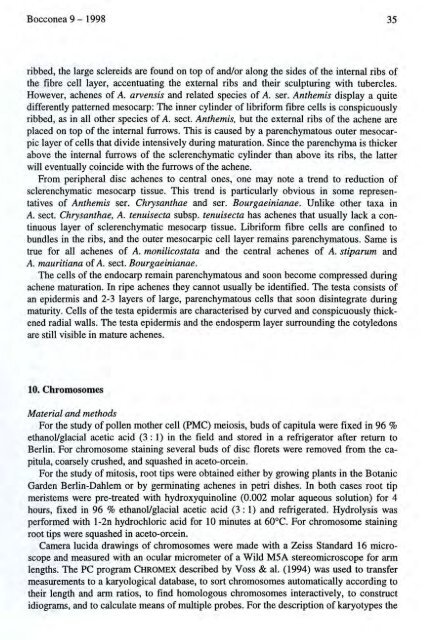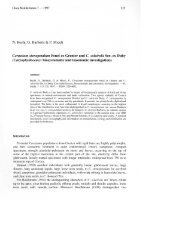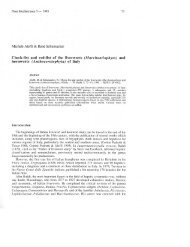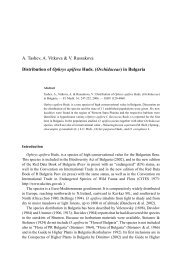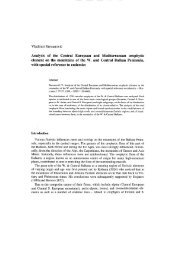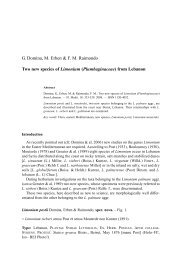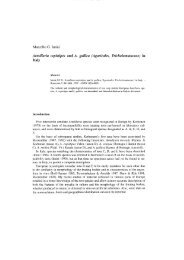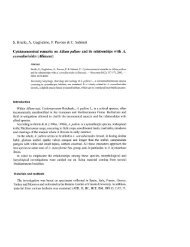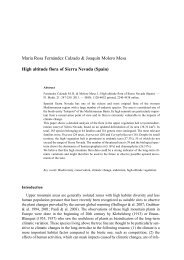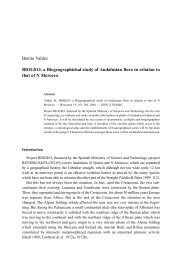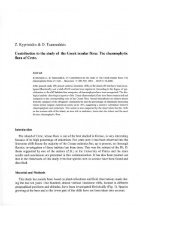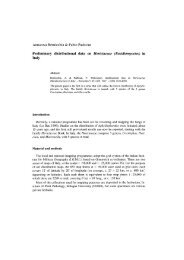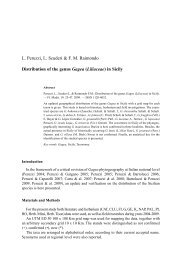Christoph Oberprieler The Systematics of Anthemis L. - Herbmedit.org
Christoph Oberprieler The Systematics of Anthemis L. - Herbmedit.org
Christoph Oberprieler The Systematics of Anthemis L. - Herbmedit.org
You also want an ePaper? Increase the reach of your titles
YUMPU automatically turns print PDFs into web optimized ePapers that Google loves.
Bocconea 9 - 1998 35<br />
ribbed, the large sc1ereids are found on top <strong>of</strong> and/or along the sides <strong>of</strong> the internaI ribs <strong>of</strong><br />
the fibre cell layer, accentuating the external ribs and their sculpturing with tuberc1es.<br />
However, achenes <strong>of</strong> A. arvensis and related species <strong>of</strong> A. ser. <strong>Anthemis</strong> display a quite<br />
differently patterned mesocarp: <strong>The</strong> inner cylinder <strong>of</strong> libriform fibre cells is conspicuously<br />
ribbed, as in all other species <strong>of</strong> A. sect. <strong>Anthemis</strong>, but the external ribs <strong>of</strong> the achene are<br />
placed on top <strong>of</strong> the internaI furrows. This is caused by a parenchymatous outer mesocarpic<br />
layer <strong>of</strong> cells that divide intensively during maturation. Since the parenchyma is thicker<br />
above the internaI furrows <strong>of</strong> the sc1erenchymatic cylinder than above its ribs, the latter<br />
will eventually coincide with the furrows <strong>of</strong> the achene.<br />
From peripheral disc achenes to centraI ones, one may note a trend to reduction <strong>of</strong><br />
sc1erenchymatic mesocarp tissue. This trend is particularly obvious in some representatives<br />
<strong>of</strong> <strong>Anthemis</strong> ser. Chrysanthae and ser. Bourgaeinianae. Unlike other taxa in<br />
A. sect. Chrysanthae, A. tenuisecta subsp. tenuisecta has achenes that usually lack a continuous<br />
layer <strong>of</strong> sc1erenchymatic mesocarp tissue. Libriform fibre cells are confined to<br />
bundles in the ribs, and the outer mesocarpic cell layer remains parenchymatous. Same is<br />
true for all achenes <strong>of</strong> A. monilicostata and the centraI achenes <strong>of</strong> A. stiparum and<br />
A. mauritiana <strong>of</strong> A. sect. Bourgaeinianae.<br />
<strong>The</strong> cells <strong>of</strong> the endocarp remai n parenchymatous and soon become compressed during<br />
achene maturation. In ripe achenes they cannot usually be identified. <strong>The</strong> testa consists <strong>of</strong><br />
an epiderrnis and 2-3 layers <strong>of</strong> large, parenchymatous cells that soon disintegrate during<br />
maturity. Cells <strong>of</strong> the testa epiderrnis are characterised by curved and conspicuously thickened<br />
radiai walls. <strong>The</strong> testa epiderrnis and the endosperm layer surrounding the cotyledons<br />
are still visible in mature achenes.<br />
lO. Chromosomes<br />
Material and methods<br />
Far the study <strong>of</strong> pollen mother cell (PMC) meiosis, buds <strong>of</strong> capitula were fixed in 96 %<br />
ethanol/glacial acetic acid (3 : l) in the field and stored in a refrigerator after return to<br />
Berlin. For chromosome staining several buds <strong>of</strong> disc florets were removed from the capitula,<br />
coarsely crushed, and squashed in aceto-orcein.<br />
For the study <strong>of</strong> rnitosis, root tips were obtained either by growing plants in the Botanic<br />
Garden Berlin~Dahlem or by gerrninating achenes in petri dishes. In both cases root tip<br />
meristems were pre-treated with hydroxyquinoline (0.002 molar aqueous solution) for 4<br />
hours, fixed in 96 % ethanol/glacial acetic acid (3 : l) and refrigerated. Hydrolysis was<br />
performed with 1-2n hydrochloric acid for lO rninutes at 60°C. For chromosome staining<br />
root tips were squashed in aceto-orcein.<br />
Camera lucida drawings <strong>of</strong> chromosomes were made with a Zeiss Standard 16 rnicroscope<br />
and measured with an ocular rnicrometer <strong>of</strong> a Wild M5A stereornicroscope for arm<br />
lengths. <strong>The</strong> PC program CHROMEX described by Voss & al. (1994) was used to transfer<br />
measurements to a karyological database, to sort chromosomes automatically according to<br />
their length and arm ratios, to find homologous chromosomes interactively, to construct<br />
idiograms, and to calculate means <strong>of</strong> multiple probes. For the description <strong>of</strong> karyotypes the


